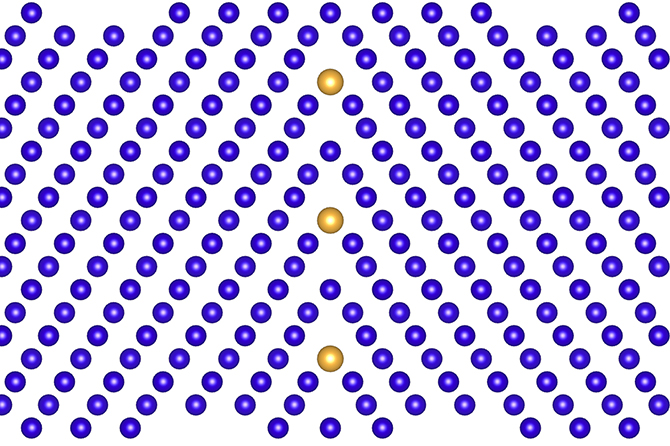Hard as ceramic, tough as steel
Newly discovered connection could help with designing nextgen alloys.
Newly discovered connection could help with designing nextgen alloys.

A new way to calculate the interaction between a metal and its alloying material could speed the hunt for a new material that combines the hardness of ceramic with the resilience of metal.
The discovery, made by engineers at the University of Michigan, identifies two aspects of this interaction that can accurately predict how a particular alloy will behave—and with fewer demanding, from-scratch quantum mechanical calculations.
“Our findings may enable the use of machine learning algorithms for alloy design, potentially accelerating the search for better alloys that could be used in turbine engines and nuclear reactors,” said Liang Qi, an assistant professor of materials science and engineering who led the research.
Today’s jet engines and nuclear reactors can’t get too hot or else the metal of the engine’s turbine or the reactor’s internal components would soften. However, jet engines could operate more efficiently and nuclear reactors could be safer if they could sustain higher temperatures, said Qi. The search is on for a material that is very hard even at high temperatures but also resistant to cracking.
Materials scientists approach this problem through alloys—mixing a metal with one or more other elements. A metal is mainly composed of a crystal lattice, with the atoms packed together in an orderly way. However, it is the defects—or the locations where the lattice is disrupted—that have the most influence over how a material will behave, Qi explained.
“The properties of defects decide mechanical, thermal and irradiation performances of metals because atoms at defects usually have fewer constraints to move around compared with those at perfect positions,” said Qi.
Some defects are points of weakness, such as breaks in the lattice that cover large areas—known as grain boundaries. But small defects, such as dislocations of several rows of atoms, can improve a metal’s performance by enabling it to bend, for example. Alloying elements combine with defects to create a network of disruptions in the lattice of the host metal, but it’s hard to predict how that network will affect the metal’s performance.
The team limited their study to metals with just one alloying element at defects—still a considerable design space with hundreds of material combinations and millions of defect structures.
We were amazed to find that the predictive power held for different types of defects and sites, given a particular metal crystal and alloying element.”
Yong-Jie Hu, postdoctoral researcher in materials science and engineering
Electrons are responsible for linking the atoms of the lattice together, so the team looked for a connection between the way electrons are structured in an ordinary lattice atom and an atom at a defect—and how this changes the way that the lattice interacts with an alloying element. A high interaction energy between the metal and alloying element at the defect usually makes the metal less flexible, for example, while a lower energy means they aren’t so tightly knit.
The team identified two measures, which they call “descriptors,” that represent how the structure of the electrons changes at the defect in the pure metal. Using these, they could figure out how an alloying element would interact with the defect.
“We were amazed to find that the predictive power held for different types of defects and sites, given a particular metal crystal and alloying element,” said Yong-Jie Hu, a postdoctoral researcher in materials science and engineering and first author on the paper in Nature Communications.
The team found that they could predict how atoms of the alloying element concentrated at various kinds of defects—including complex types such as high angle grain boundaries, where the lattice is majorly misaligned. The identification of these descriptors is a significant step toward being able to harness machine learning effectively for alloy design, using algorithms to trawl through the results of highly accurate but computationally intensive quantum mechanical simulations.
However, they note that more descriptors must be discovered for predictions of how more complex alloys will behave, for instance those with two or more alloying elements at defects. And while these descriptors may feed into machine learning, humans will probably identify them.
“The discovery was made through ‘human learning’ from classical electronic models,” Qi noted. “It indicates that, in the age of big data and artificial intelligence, human intelligence still provides reliable resources for scientific discoveries.”
A paper on this research is published in the journal Nature Communications, titled, “Local electronic descriptors for solute-defect interactions in bcc refractory metals.”
The research was funded by the National Science Foundation and the University of Michigan.